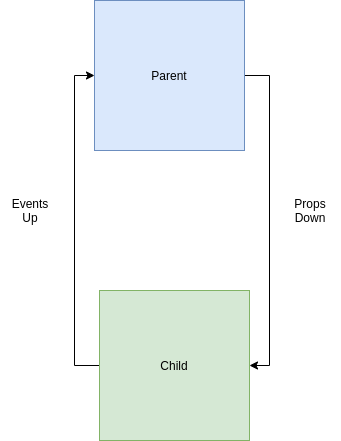Open console to view form payloads.
.
├── package.json
├── public
│ ├── favicon.ico
│ └── index.html
├── README.md
└── src
├── App.vue // root component
├── components
│ ├── base
│ │ ├── BaseInput.vue
│ │ └── BaseSelect.vue
│ ├── BasicForm.vue
│ ├── DynamicFormField.vue
│ └── UpdateUserForm.vue
├── containers
│ └── FormContainer.vue
├── data
│ ├── mainFormSchema.json
│ ├── secondFormSchema.json
│ └── users.js
├── main.js
├── mixins
│ └── validation.js // used to provide validation functionality
└── utils
├── schemaParser.js
└── validators.js // validators used by validation mixin
Communication between components sending props from parent to child and emitting events and subsequent data changes using $emit.
In the props-down and events-up pattern, the parent component’s data object is the single source of truth for the whole application. Child components should receive data from the parent’s data object via props — “props-down”. And parent component should update its state by handling events emitted from child components — “events-up”.
FormContainer in this case acting as the container holding the state and source of truth.
The the form value state is held in form and the state of validations against the form in formValidations.
data() {
return {
form: {},
formValidations: {},
};
},These values are updated on input events via v-model=form[name] and update events handled in onValueUpdate. You can read more about how v-model works here.
Note the use of v-on="$listeners" in each usage of FormContainer. This technique allows for the listeners from DynamicForm and UpdateUserForm (the parent) to be applied to FormContainer (the child). In this case the only listener is the submit event, which is transparently passed from FormContainer to the parent component.
Any event can be passed from the child to the parent for example:
<DynamicForm @error="onError" @submit="submitDynamicForm" />Here, onError would be triggered if FormContainer emitted an "error" event like so $emit('error', value), any custom or DOM event from a child can be listened to by the parent using v-on="$listeners" without explicitly passing that event from child to parent.
However, as we are only listening to the submit event, the same result can be achieved by explicitly emitting the event up the component tree like so (as seen in StaticForm):
<FormContainer @submit="$emit('submit', $event)">
....
</FormContainer>v-on="$listeners" is similar in concept to $attrs. So much so they are combined them in Vue 3. They are a powerful part of Vue's API, but like slots and dynamic components can be a little abstract initially.
The form layout can be cutomised using named slots. Default values are provided in the field by using the DynamicFormField component for each element in the schema and action slots which must be a button of type submit in order to trigger the submit handler, there is an optional header layout used in UpdateUserForm.
Dynamic fields are generated using vues dynamic component functionality. The component name is setup in schemaParser.js and dynamically imported and returned in the a computed property of DynamicFormField
Validations are dynamically assigned to fields via createValidations found here, those validations are then applied via a mixin. The application and interface to apply validations is largely inspired by vuelidate.
When the "action" button is clicked it will trigger form validation which checks each value in the formValidations state and ensures that all have passed. The initial formValidations are setup in the created lifecycle hook of the DynamicFormField.
The submit event is emitted on form submition using @submit.prevent,note the use of the .prevent modifier which prevents the default action of the form allowing the event to be handled in the onSubmit method.
Using the header slot to add in a BaseSelect component to allow for selection of a user from a list which is generated by faker. Once a user is selected the values are used to provide initialFormValues which are applied to the form data. The initialFormValues prop is watched in FormContainer and applied on to form state on value change.

